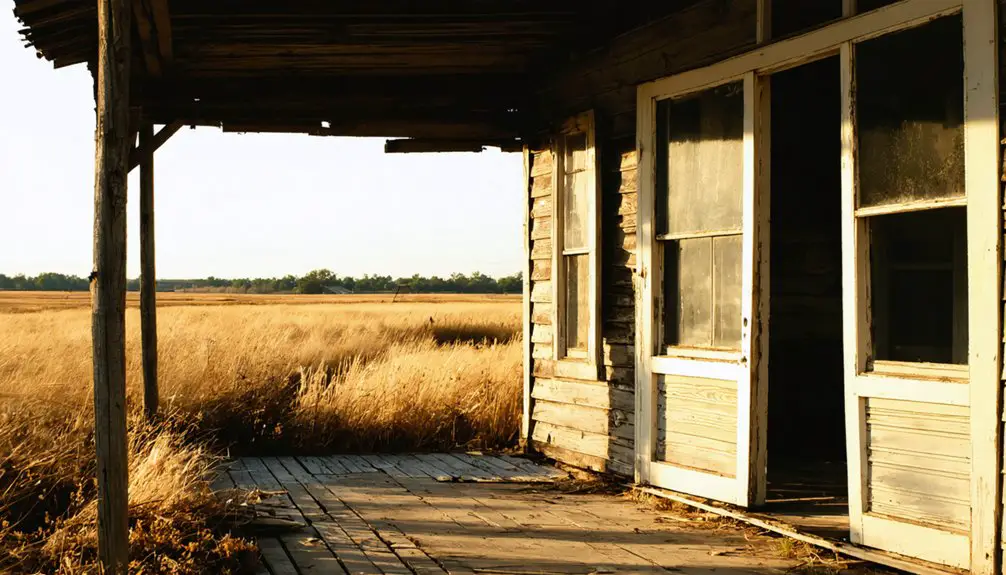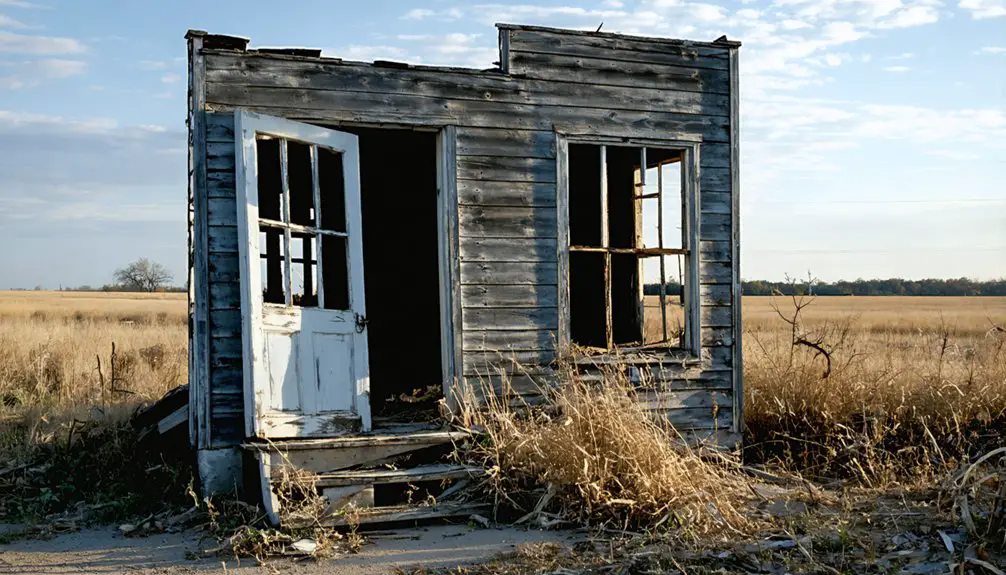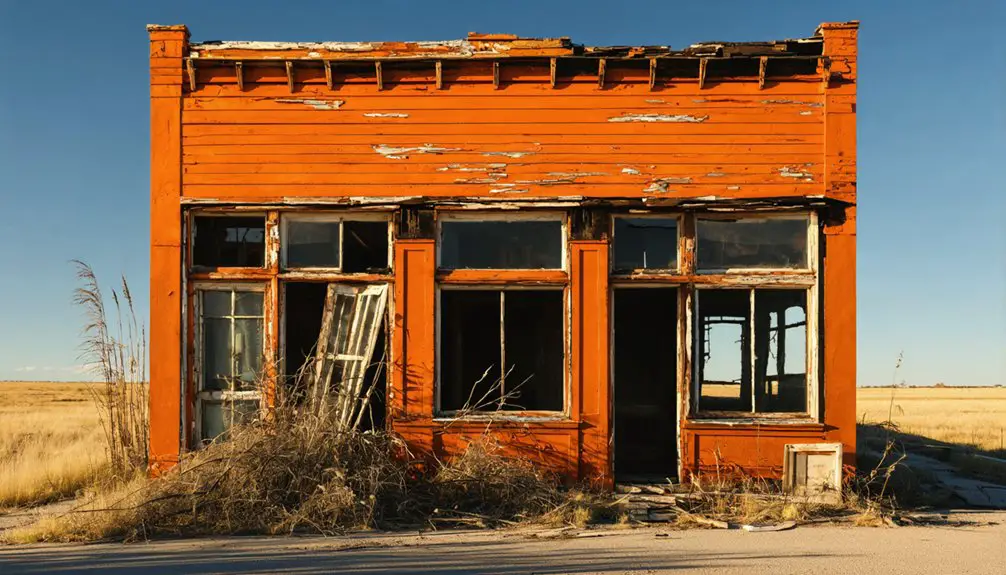You’ll find Jester, Oklahoma in Greer County, where David C. Jester established a ranching community in 1890. He managed 300 cattle across five sections of land while larger operations like Ikard and Harrold Ranch controlled up to 70,000 head nearby. Though the town thrived initially, it couldn’t survive being bypassed by major railroad lines. Today, abandoned buildings and deteriorating streets tell the story of this once-bustling frontier settlement. The town’s rich history reveals much more about Oklahoma’s dramatic territorial transformation.
Key Takeaways
- Jester was founded around 1890 by David C. Jester, who established a two-room house and managed 300 cattle across five sections of land.
- Located in Greer County, Oklahoma near Deer Creek, Jester thrived initially as a ranching community with cotton and corn farming.
- The town’s decline began when major railroad lines bypassed the area, isolating it from vital trade routes and economic opportunities.
- Rural depopulation accelerated as younger generations moved to urban centers, leading to abandoned buildings and deteriorating infrastructure.
- Today, Jester stands as a ghost town with remaining structures that showcase its history as a once-prosperous ranching community.
The Birth of a Ranching Community
While much of Oklahoma Territory saw rapid development in the late 19th century, the birth of Jester’s ranching community began modestly with David C. Jester‘s two-room frame house built around 1890.
You’ll find his operation, managing 300 cattle across five sections of land, exemplified the resilience of small-scale ranchers amid giants like the Ikard and Harrold Ranch, which controlled up to 70,000 head nearby.
The area’s ranching culture thrived on open ranges, where cattlemen like Jim Haney, Ed Handy, John Powers, and Mat Murphy ran herds of 15,000 to 20,000 head.
When the U.S. Supreme Court transferred Greer County from Texas to Oklahoma Territory in 1896, the community adapted, showcasing their determination to maintain their way of life despite changing jurisdictions.
The settlers worked the fertile soil of the Red Bed Plains in the eastern portion of the county, making agriculture increasingly important to the local economy.
The region’s agricultural focus gradually shifted as settlers established farms, with cotton and corn becoming major crops by the early 1900s.
David C. Jester’s Legacy
A devoted pioneer and rancher, David Corey “Uncle Dave” Jester left an indelible mark on northwestern Greer County through his community-building efforts from 1890 to 1952.
You’ll find his Jester heritage woven into the fabric of the region, from the town that bears his name to the cemetery he generously established for local families.
Managing 300 cattle across five sections of land, Jester embodied the spirit of community resilience during Greer County’s change from Texas to Oklahoma Territory.
Across five sections of Oklahoma land, Jester’s 300-head cattle operation exemplified the resilient spirit of early territory ranchers.
Born to Eli Jester Jr and Sarah Schenck in 1854, he carried forward his family’s pioneering spirit.
After his first wife Kate Jester’s death in 1887, he remarried Laura Ellen Cunningham in 1890 and continued his ranching legacy.
His two-room ranch house became a symbol of the modest yet significant ranching operations that defined the area.
Through his 96-year lifetime, you can trace the evolution of Old Greer County, as he and his wife Kate raised four children while contributing to the foundation of a thriving ranching community.
Life in Early Greer County
During the 1880s, life in early Greer County centered around vast cattle operations and frontier settlement challenges. You’d find only about ten families among the 60,000 cattle, with major ranching outfits like Day Land and Cattle Company dominating the landscape. Construction plans emerged for a county jail at a cost of $11,000.
Despite territorial disputes between Texas and Oklahoma, the community’s resilience shone through as they established their own government in 1886, with Mangum as the county seat.
You would’ve witnessed remarkable growth following the 1896 Supreme Court decision, as settlers rushed to file over three thousand homestead applications. This pivotal ruling transferred 1.5 million acres to Oklahoma Territory. The community quickly built infrastructure, including two post offices and 66 school districts serving 2,250 pupils by 1892.
When you needed legal matters handled before local governance, you’d make the long journey to Wheeler County, Texas.
The Golden Age of Cattle Operations
If you’d visited Jester during the cattle industry’s peak, you’d have seen sprawling ranches running thousands of head of cattle across the open plains of Greer County.
The area’s major ranching operations contributed considerably to Oklahoma Territory’s booming cattle economy, with eastern cattle buyers offering $30-50 per head at the Kansas railheads.
Your journey through Jester would have revealed the economic prosperity brought by wealthy cattle speculators and eastern businessmen who invested heavily in local ranching ventures, transforming the region into a crucial hub of livestock commerce. The introduction of barbed wire and windmills in the territory helped ranchers improve their operations and upgrade their cattle breeds. The transcontinental railroad enabled ranchers to transport their cattle efficiently to lucrative eastern markets, boosting the region’s economic growth.
Massive Ranch Stock Numbers
Thousands of cattle roamed the open ranges of western Greer County during the early 1880s, marking ranching’s golden age in the region.
You’d find massive operations like the Ikard and Harrold Ranch managing up to 70,000 head of cattle near present-day Granite, while the Day Land and Cattle Company controlled similarly impressive herds.
These operations required extensive cattle management across tens of thousands of unfenced acres, where ranching techniques adapted to the semi-arid conditions.
Like her fellow Oklahoman Sharen Turney who grew up on a working farm, early settlers like David C. Jester earned their living as farm hands before establishing smaller outfits that ran about 300 head on five sections of land, demonstrating the diverse scale of operations.
The sheer volume of livestock supported the local economy, driving growth in Mangum and surrounding communities while creating opportunities in freight, supplies, and related services.
Prominent Ranching Operations Nearby
While the post-Civil War era ushered in widespread cattle operations across Indian Territory, the area near Jester saw particularly notable ranching development.
You’ll find that prominent ranchers introduced significant ranching innovations, including diversified cattle breeds to withstand Oklahoma’s challenging climate. The shift from open tribal grazing to private operations accelerated with the adoption of barbed wire fencing, fundamentally changing how ranchers managed their herds.
- Ranch headquarters served as crucial economic hubs, coordinating massive cattle drives to Kansas railheads.
- Local ranchers pioneered breeding programs to develop hardier stock suited for native buffalo grass pastures.
- Major operations expanded their influence by establishing connections to emerging stockyards and regional markets.
These ranching empires helped transform the region from communal grazing lands into a commercial beef powerhouse.
Cattle Industry Economic Impact
The cattle industry transformed Oklahoma’s economic landscape during its golden age, propelling the territory to become the nation’s fourth-largest beef producer.
You’ll find that cattle trade through the region exploded after the Civil War, with over 5 million head moving north via the Chisholm Trail alone. The Five Tribes’ communal grazing systems had already established a strong foundation, with the Cherokee managing 250,000 cattle by the Civil War.
When railroads connected Oklahoma to eastern markets, you could see dramatic economic diversification taking hold. Cattle worth $3-5 in Texas sold for ten times more in eastern cities, spurring rapid growth in banking, lodging, and supply businesses.
Cowtowns flourished along the trails, while entrepreneurs and cowboys alike found new opportunities in this booming frontier economy.
Geographic Features and Natural Setting
Situated among rugged terrain in Greer County, Oklahoma, Jester’s ghost town lies nine miles north and eleven miles west of Mangum, nestled along a tributary of Deer Creek. The landscape’s stark beauty reveals low granite mountains to the east, while the surrounding area remains dry and desolate. Water availability from the creek tributary has historically shaped settlement patterns and continues to influence the local ecosystem.
Deep in Oklahoma’s Greer County, Jester stands abandoned amid harsh granite hills, its fate tied to precious water from Deer Creek.
- Semi-arid climate creates challenging conditions with hot summers and mild winters
- Part of the area now falls within Sandy Sanders Wildlife Management Area
- Agricultural adaptation has led to successful peanut and cotton farming despite rugged terrain
The region’s geological features, including distinctive granite formations, contribute to both its challenging topography and natural resource value, while seasonal precipitation supports drought-tolerant agriculture in suitable areas.
From Texas to Oklahoma Territory

Migration patterns between Texas and Oklahoma Territory shaped the region’s early development, beginning with Cherokee settlements near the Red River in 1807. Spanish officials encouraged Cherokee migration into Texas, using them as a buffer against American expansion. By 1822, around 300 Cherokee had settled on former Caddo lands.
The Texas Road became a vital route connecting these territories, running through key sites like North Fork Town, Perryville, and Boggy Depot.
You’ll find the route was heavily traveled, with over 100,000 wagons passing annually by the late 1850s. Choctaw-operated ferries, especially near present-day Colbert, made crossing the Red River easier.
The route served multiple purposes, from facilitating settlement to supporting California Gold Rush travelers and cattle drives.
The Path to Abandonment
Despite early promise from cattle ranching and agricultural ventures in Greer County, Jester’s path to abandonment began through a complex web of economic and infrastructural challenges.
Once-promising Jester fell victim to economic hardship and poor infrastructure, sealing its fate as a ghost town.
You’ll find that major railroad lines bypassed the town, isolating it from essential trade routes and stunting its growth potential. The community faced mounting economic challenges as agricultural profitability declined, forcing residents to seek opportunities elsewhere.
- The absence of economic diversification left Jester vulnerable when farming and ranching markets fluctuated.
- Limited transportation access decreased commercial activity and deterred new investments.
- Rural depopulation accelerated as younger generations moved to urban centers, leaving fewer residents to maintain local institutions.
Without sufficient population to sustain businesses and services, Jester gradually transformed from a hopeful settlement into another Oklahoma ghost town.
What Remains Today

Remnants of Jester’s once-vibrant community dot the Oklahoma landscape through deteriorating structures and vacant properties.
You’ll find several abandoned buildings, including homes and an old motel, their windows broken and roofs partially collapsed. Service stations stand as silent witnesses to busier times, while rusty signs mark where businesses once thrived.
If you’re interested in ghost town tourism, you can explore the deteriorating streets where nature’s slowly reclaiming the town.
The concrete foundations and empty lots tell stories of previous development, while wild vegetation spreads unchecked across the former town center.
Unlike some Oklahoma ghost towns that face contamination issues, Jester’s remains are primarily structural, offering you a glimpse into mid-20th century small-town life without environmental hazards.
Historical Significance in Western Oklahoma
The history of Jester began with David C. Jester, a prominent rancher whose 1890s ranch house exemplified early Western Oklahoma settlement. The town’s evolution mirrors the cultural heritage of Greer County’s transformation from Texas jurisdiction to Oklahoma Territory following the 1896 Supreme Court decision.
- You’ll find Jester’s origins rooted in territorial disputes between Texas and Oklahoma, reshaping local governance and property rights.
- The area’s significance extends to its Native American history, serving as hunting grounds for Kiowa and Comanche tribes before ranching emerged.
- Your understanding of Western Oklahoma’s development isn’t complete without recognizing how Jester’s ranching economy contributed to regional growth, with operations managing 300 cattle across five sections of land.
This settlement helped establish the region’s transportation routes and population patterns that would define early Oklahoma Territory.
Frequently Asked Questions
Are There Any Ghost Town Tours or Guided Visits to Jester?
You won’t find official guided tours to explore this ghost town’s history. You’ll need to plan your own visit, as organized explorations aren’t currently available in this remote, privately-owned location.
What Paranormal Activities or Legends Are Associated With Jester’s Abandoned Sites?
You’ll encounter haunting tales of spectral clowns, shadow figures, and disembodied voices. Former circus grounds yield reports of ghostly performers, while abandoned buildings echo with unexplained noises and floating apparitions.
Can Visitors Legally Explore and Photograph the Remaining Structures?
You’ll need to check Wildlife Management Area rules and obtain permissions first. Legal restrictions limit access, while photography guidelines allow landscape shots but discourage close inspection of any unstable structures.
Were Any Movies or Television Shows Ever Filmed in Jester?
While you might expect this eerie location to attract film crews for haunted scenes, there’s no evidence of any movies or TV shows using Jester as one of their film locations.
What Valuable Artifacts Have Been Discovered in Jester’s Ghost Town Ruins?
Like treasure boxes from the past, you’ll find burnt ceramics, limestone chimney remnants, historic nails, and building foundations among the discovered artifacts that tell the tale of daily life and commerce.
References
- https://www.youtube.com/watch?v=5d-wHDTIbb0
- https://www.okhistory.org/publications/enc/entry?entry=GH002
- https://www.okhistory.org/publications/enc/entry?entry=GR025
- https://pastmaps.com/explore/us/oklahoma/greer-county/jester/hiking-exploration
- https://kids.kiddle.co/List_of_ghost_towns_in_Oklahoma
- http://genealogytrails.com/oka/greer/countyhistory.html
- https://www.okhistory.org/learn/cowhands4
- https://okgenweb.net/~okgreer/brnkfarm.html
- https://oklahomahistory.net/russett/history/history1.html
- https://www.findagrave.com/memorial/12415395/david-corey-jester



